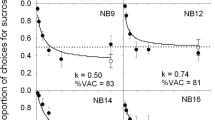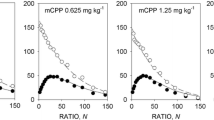Abstract
Two experiments were run in which rats were rewarded with food for running in a straight alley at one trial a day, followed by extinction of the running response. During acquisition of the response, reward was delivered either on a continuous reinforcement (CRF) or on a quasirandom 50% partial reinforcement (PRF) schedule. The groups given PRF were more resistant to extinction than those given CRF, the well-known partial reinforcement extinction effect. In Experiment 1 different groups of rats were injected during acquisition only with 1, 5 or 10 mg/kg of the benzodiazepine antagonist, RO 15-1788, or with placebo. In Experiment 2, 5 mg/kg RO 15-1788 or placebo were administered in a full cross-over design during acquisition, extinction or both. At the end of Experiment 2 only [3H]-flunitrazepam binding was measured in either the presence or absence of added γ-aminobutyrate (GABA) in homogenates of hippocampi dissected from the animals that had received behavioural training. The drug affected running speeds during both acquisition and extinction in different ways depending upon the schedule of reinforcement (CRF or PRF) and also gave rise to enhanced GABA stimulation of [3H]-flunitrazepam binding. The results are discussed in relation to the hypothesis that the neurochemical pathways by which reinforcement schedules modify behaviour include a step influenced by benzodiazepine receptors.
Similar content being viewed by others
References
Boarder MR, Feldon J, Gray JA, Fillenz M. (1979) Effect of runway training on rat brain tyrosine hydroxylase: differential effect of continuous and partial reinforcement schedules. Neurosci Lett 15:211–215
Feldon J, Gray JA (1981a) The partial reinforcement extinction effect after treatment with chloridazepoxide. Psychopharmacology 73:269–275
Feldon J, Gray JA (1981b) The partial reinforcement extinction effect: influence of chlordiazepoxide in septal-lesioned rats. Psychopharmacology 74:280–289
File SE, Pellow S (1986) Intrinsic actions of the benzodiazepine receptor antagonist RO 15–1788. Psychopharmacology 88:1–11
Gallager DW, Lakoski JM, Gonsalves SF, Rauch SL (1984) Chronic benzodiazepine treatment decreases postsynaptic GABA sensitivity. Nature 308:74–77
Gray JA, McNaughton N, James DTD, Kelly PH (1975) Effect of minor tranquillisers on hippocampal theta rhythm mimicked by depletion of forebrain noradrenaline. Nature 258:424–425
Gray JA, Feldon J, Rawlins JNP, Owen S, McNaughton N (1978) The role of the septo-hippocampal system and its noradrenergic afferents in behavioural responses to nonreward. In: Elliott K, Whelan J (eds) Functions of the septo-hippocampal system. Ciba Foundation Symposium No. 58 (New Series), Elsevier, Amsterdam, pp 275–300
Gray JA, McNaughton N, Holt L, Tsaltas E, Feldon J, Shemer A (1982) The effects of anti-anxiety drugs on tolerance for stress. In: Levy A, Spiegelstein MY (eds) Behavioural models and the analysis of drug action. Elsevier, Amsterdam, pp 175–194
Gray JA, Quintero A, Mellanby J, Buckland C, Fillenz M, Fung SC (1984) Some biochemical, behavioural and electrophysiological tests of the GABA hypothesis of anti-anxiety drug action. In: Bowery NG (ed) Actions and interactions of GABA and benzodiazepines. Raven Press, New York, pp 239–262
Guyenet PG, Aghajanian GK (1979) ACh, substance P and metenkephalin in the locus coeruleus: pharmacological evidence for independent sites of action. Eur J Pharmacol 53:319–328
Haefely W (1984) Actions and interactions of benzodiazepine agonists at GABAergic synapses. In: Bowery NG (ed) Actions and interactions of GABA and benzodiazepines. Raven Press, New York, pp 263–285
Haefely W, Kyburz E, Gerecke M, Möhler H (1985) Recent advances in the molecular biology of benzodiazepine receptors and in the structure-activity relationships of their agonists and antagonists. In: Testa B (ed) Advances in drug research. Academic Press, London, pp 165–322
Hunkeler M, Mohler H, Pierie L, Polc C, Bonnetti EP, Cumin R, Schaffner R, Haefely W (1981) Selective antagonists of benzodiazepines. Nature 290:514
McNaughton N (1984) Effects of anxiolytic drugs on the partial reinforcement effect in runway and Skinner box. Q J Exp Psychol 36 B:319–330
McNaughton N, James DTD, Stewart J, Gray JA, Valero I and Drewnowski A (1977) Septal driving of hippocampal theta rhythm as a function of frequency in the male rat: effects of drugs. Neuroscience 2:1019–1027
Overton DA (1966) State-dependent learning produced by depressant and atropine-like drugs. Psychopharmacologia 10:6–31
Owen S, Boarder M, Gray JA and Fillenz M (1982) Acquisition and extinction of continuously and partially reinforced running in rats with lesions of the dorsal noradrenergic bundle. Behav Brain Res 5:11–41
Quintero S, Mellanby J, Thompson MR, Nordeen H, Nutt D, McNaughton N, Gray JA (1985) Septal driving of hippocampal theta rhythm: role of γ-aminobutyrate-benzodiazepine receptor complex in mediating effects of anxiolytics. Neuroscience 16:875–884
Author information
Authors and Affiliations
Rights and permissions
About this article
Cite this article
Hawkins, M., Sinden, J., Martin, I. et al. Effects of RO 15-1788 on a running response rewarded on continuous or partial reinforcement schedules. Psychopharmacology 94, 371–378 (1988). https://doi.org/10.1007/BF00174692
Received:
Revised:
Issue Date:
DOI: https://doi.org/10.1007/BF00174692




